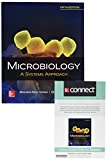
GEN COMBO LOOSELEAF MICROBIOLOGY:A SYSTEMS APPROACH; CONNECT ACCESS CARD
5th Edition
ISBN: 9781260149364
Author: Marjorie Kelly Cowan Professor
Publisher: McGraw-Hill Education
expand_more
expand_more
format_list_bulleted
Concept explainers
Question
Chapter 16.3, Problem 11AYP
Summary Introduction
To determine:
The role of Rh factor in hemolytic disease development and how this disease is prevented in newborns.
Concept introduction:
Rh factor is a type of antigen present in the blood (known as the D antigen). This antigen is present in 85% of the total population. Rh blood type is a result of combination of two alleles. A dominant allele which codes for the factor and a recessive allele which does not code for such factor. If a person inherits even a single Rh gene, then the blood group will be Rh-positive (Rh+). Only persons inheriting both recessive genes are Rh-negative (Rh−).
Expert Solution & Answer
Trending nowThis is a popular solution!

Students have asked these similar questions
What is the structure and function of Eukaryotic cells, including their organelles? How are Eukaryotic cells different than Prokaryotic cells, in terms of evolution which form of the cell might have came first? How do Eukaryotic cells become malignant (cancerous)?
What are the roles of DNA and proteins inside of the cell? What are the building blocks or molecular components of the DNA and proteins? How are proteins produced within the cell? What connection is there between DNA, proteins, and the cell cycle? What is the relationship between DNA, proteins, and Cancer?
Why cells go through various types of cell division and how eukaryotic cells control cell growth through the cell cycle control system?
Chapter 16 Solutions
GEN COMBO LOOSELEAF MICROBIOLOGY:A SYSTEMS APPROACH; CONNECT ACCESS CARD
Ch. 16.1 - Define immunopathology, and describe the two major...Ch. 16.1 - Prob. 2AYPCh. 16.2 - Prob. 3AYPCh. 16.2 - Outline the steps of a type I allergic response,...Ch. 16.2 - Identify three conditions caused by IgE-mediated...Ch. 16.2 - Prob. 6AYPCh. 16.2 - Prob. 7AYPCh. 16.2 - Prob. 8AYPCh. 16.3 - List the three immune components causing cell...Ch. 16.3 - Prob. 10AYP
Ch. 16.3 - Prob. 11AYPCh. 16.4 - Prob. 12AYPCh. 16.4 - Prob. 13AYPCh. 16.5 - Prob. 14AYPCh. 16.5 - List four classes of grafts, and explain how host...Ch. 16.6 - Prob. 16AYPCh. 16.6 - Prob. 17AYPCh. 16.7 - Prob. 18AYPCh. 16.7 - Prob. 19AYPCh. 16.7 - Prob. 20AYPCh. 16 - Prob. 1MCQCh. 16 - Prob. 2MCQCh. 16 - The contact with allergen that results in symptoms...Ch. 16 - Prob. 4MCQCh. 16 - Prob. 5MCQCh. 16 - Prob. 6MCQCh. 16 - Prob. 7MCQCh. 16 - Prob. 8MCQCh. 16 - Prob. 9MCQCh. 16 - Prob. 10MCQCh. 16 - Prob. 11TFCh. 16 - Prob. 12TFCh. 16 - Prob. 13TFCh. 16 - Prob. 14TFCh. 16 - Prob. 15TFCh. 16 - Prob. 1CTQCh. 16 - Summarize the roles of the microbiome and genetics...Ch. 16 - Prob. 3CTQCh. 16 - Prob. 4CTQCh. 16 - Prob. 5CTQCh. 16 - From chapter 15. figure 15.1. How would a persons...Ch. 16 - Prob. 2VCCh. 16 - Prob. 1CM
Knowledge Booster
Learn more about
Need a deep-dive on the concept behind this application? Look no further. Learn more about this topic, biology and related others by exploring similar questions and additional content below.Similar questions
- In one paragraph show how atoms and they're structure are related to the structure of dna and proteins. Talk about what atoms are. what they're made of, why chemical bonding is important to DNA?arrow_forwardWhat are the structure and properties of atoms and chemical bonds (especially how they relate to DNA and proteins).arrow_forwardThe Sentinel Cell: Nature’s Answer to Cancer?arrow_forward
- Molecular Biology Question You are working to characterize a novel protein in mice. Analysis shows that high levels of the primary transcript that codes for this protein are found in tissue from the brain, muscle, liver, and pancreas. However, an antibody that recognizes the C-terminal portion of the protein indicates that the protein is present in brain, muscle, and liver, but not in the pancreas. What is the most likely explanation for this result?arrow_forwardMolecular Biology Explain/discuss how “slow stop” and “quick/fast stop” mutants wereused to identify different protein involved in DNA replication in E. coli.arrow_forwardMolecular Biology Question A gene that codes for a protein was removed from a eukaryotic cell and inserted into a prokaryotic cell. Although the gene was successfully transcribed and translated, it produced a different protein than it produced in the eukaryotic cell. What is the most likely explanation?arrow_forward
- Molecular Biology LIST three characteristics of origins of replicationarrow_forwardMolecular Biology Question Please help. Thank you For E coli DNA polymerase III, give the structure and function of the b-clamp sub-complex. Describe how the structure of this sub-complex is important for it’s function.arrow_forwardMolecular Biology LIST three characteristics of DNA Polymerasesarrow_forward
arrow_back_ios
SEE MORE QUESTIONS
arrow_forward_ios
Recommended textbooks for you
 Human Physiology: From Cells to Systems (MindTap ...BiologyISBN:9781285866932Author:Lauralee SherwoodPublisher:Cengage Learning
Human Physiology: From Cells to Systems (MindTap ...BiologyISBN:9781285866932Author:Lauralee SherwoodPublisher:Cengage Learning Human Heredity: Principles and Issues (MindTap Co...BiologyISBN:9781305251052Author:Michael CummingsPublisher:Cengage Learning
Human Heredity: Principles and Issues (MindTap Co...BiologyISBN:9781305251052Author:Michael CummingsPublisher:Cengage Learning Human Biology (MindTap Course List)BiologyISBN:9781305112100Author:Cecie Starr, Beverly McMillanPublisher:Cengage Learning
Human Biology (MindTap Course List)BiologyISBN:9781305112100Author:Cecie Starr, Beverly McMillanPublisher:Cengage Learning Principles Of Radiographic Imaging: An Art And A ...Health & NutritionISBN:9781337711067Author:Richard R. Carlton, Arlene M. Adler, Vesna BalacPublisher:Cengage Learning
Principles Of Radiographic Imaging: An Art And A ...Health & NutritionISBN:9781337711067Author:Richard R. Carlton, Arlene M. Adler, Vesna BalacPublisher:Cengage Learning


Human Physiology: From Cells to Systems (MindTap ...
Biology
ISBN:9781285866932
Author:Lauralee Sherwood
Publisher:Cengage Learning

Human Heredity: Principles and Issues (MindTap Co...
Biology
ISBN:9781305251052
Author:Michael Cummings
Publisher:Cengage Learning


Human Biology (MindTap Course List)
Biology
ISBN:9781305112100
Author:Cecie Starr, Beverly McMillan
Publisher:Cengage Learning

Principles Of Radiographic Imaging: An Art And A ...
Health & Nutrition
ISBN:9781337711067
Author:Richard R. Carlton, Arlene M. Adler, Vesna Balac
Publisher:Cengage Learning